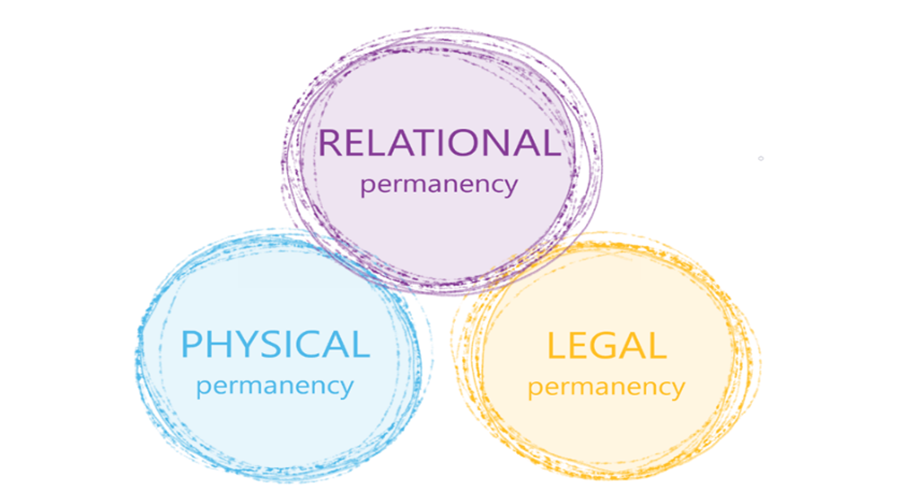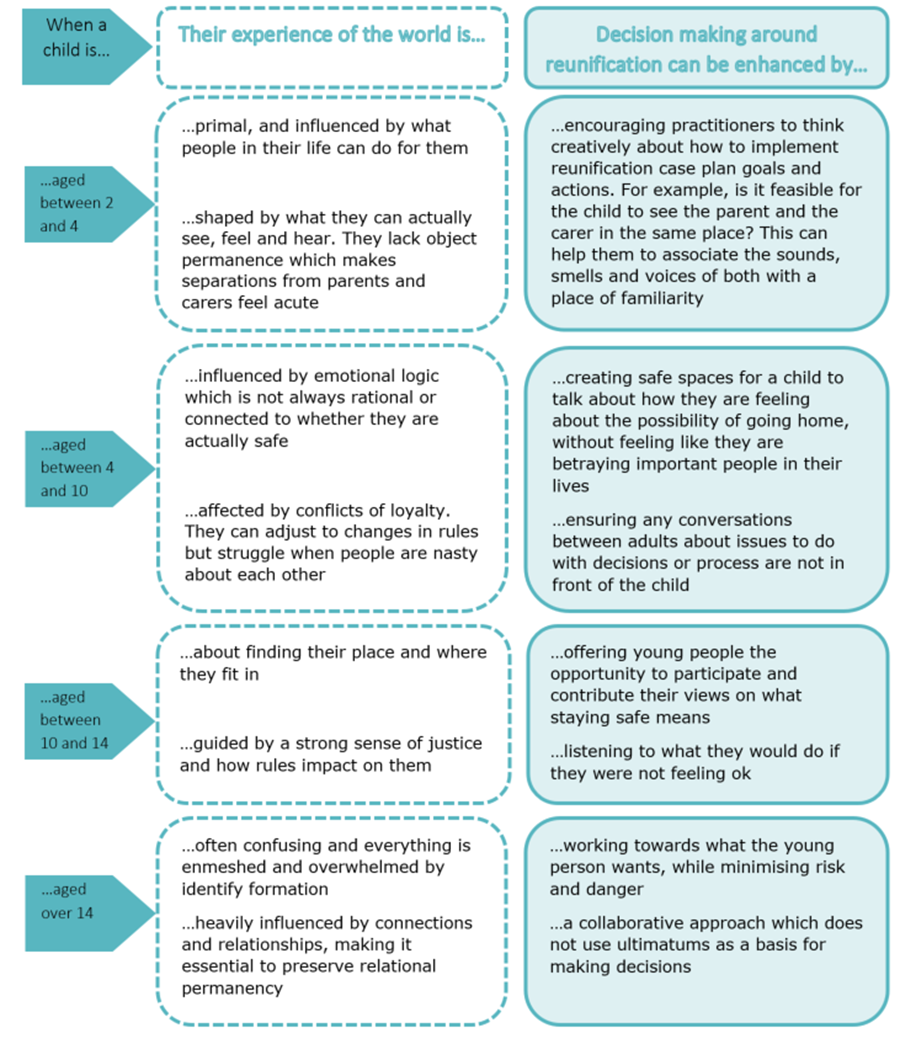In many ways, reunification is a measure of the effectiveness of the child protection system, as working with families to enable them to care safely for their child is core business. It is widely accepted that for most children, their needs for safety, belonging and wellbeing are best met by their family, at home. By partnering with families using strengths based, solution focused case work, planning early and involving support services and a support network, practitioners can help families to transform circumstances from unsafe to safe, enabling timely and sustainable reunification.
The reunification of Aboriginal and Torres Strait Islander children must be considered sensitively and in the context of colonisation and the Stolen Generations to understand the hurt that has been experienced by the removal of children from their families (SNAICC, 2019). Active efforts to reunify a child is in line with the prevention element of the Child Placement Principle. The same principles of early planning, partnering with families and timely decision making for reunification apply, and planning must also include culturally safe supports and relevant Aboriginal and Torres Strait Islander services to provide the right help to enable parents to safely care for their children.(partnership element of the Child Placement Principle) The primary services funded to work with Aboriginal and Torres Strait Islander families are Family Wellbeing Services and Family Participation Services. Family Wellbeing Services provide intervention to address child protection worries and Family Participation Services provide Aboriginal and Torres Strait Islander Family led decision making to help with engaging the whole family in planning and decision making.
Further reading
Practice kit Safe care and connection.
Bringing a child and their family back together safely is a primary task of Child Safety practitioners, and a process that requires intentional planning. It can also be resource intensive. While there are messages from research around factors associated with successful and unsuccessful returns home, there isn’t a formula for reunification to guide practice, and only a few models for reunification are available.
As well as being complex, reunification can also present a dilemma for practitioners who have a heightened awareness of the consequences of their decisions. It is hard to return a child to a home where they have experienced harm and trauma, which may still carry inherent risk and uncertainty, even with robust safety planning. Keeping a sense of urgency to planning for reunification is important and will be strengthened by working closely with families towards this goal, from day 1 of a child coming into care.
Attention
Holding a child in care without comprehensive assessment of, and action towards, reunification deprives them of their right to grow up within their family.
Case planning for reunification requires practitioners to have a thorough understanding of a child and family’s situation, including where they have been, where they are now and where they want to be. Some of the complex and competing considerations to take into account when planning for reunification include:
- assessment of previous and current risks
- the needs of the child
- parental strengths, needs and capacity to change
- the child’s views and wishes
- family context and functioning
- culture
- the relationship between the parent and child
- length of time in care
- siblings
- relationships with carers and support workers
- safety and support networks.
Concurrent case planning is essential to progress early permanency outcomes for children. As well as focusing on reunification as the primary permanency goal when developing an initial case plan with a child and family, practitioners are required to simultaneously establish an alternative permanency goal (or goals) for the child just in case reunification is not possible. Timely and robust decision making around reunification significantly influences being able to establish stability for a child and reduces the likelihood of placement breakdowns and multiple care arrangements.
Further reading
Refer to Concurrent case planning.
Remember the dimensions of permanency
It is essential to ensure planning and decision making for reunification is guided by the dimensions of permanency. Each dimension requires equal consideration and together, make up the foundation of holistic permanency practice. What arrangements are in place while the child is in a care arrangement to support relational, physical and legal permanency? How can there be continuity of connections as the child transitions from home to a care arrangement and hopefully back home again? What is the duration of the legal order and how can this time be best used to support reunification?

Relational permanency is especially important as it directly contributes to a child’s sense of self and helps them to see the continuity and stability of important relationships. Maintaining and nurturing meaningful and lifelong connections throughout a child’s journey in care can help them to see who has walked, and continues to walk, alongside them. Paying attention to positive memories which carry a history and connection can grow relational permanence, which positively supports a child on their pathway home.
Further reading
Refer to Dimensions of permanency.
Use a developmental lens
Knowledge and understanding of child development can provide a lens through which to see reunification, and decisions around this, through the eyes of the child.

Attention
A child’s behaviour and presentation can span across more than one developmental stage at a time. For example a 12 year old can behave emotionally and cognitively at a much younger age but engage in high risk activities typically associated with someone much older (Jackson and McConachy, 2014).
Understand the impact of trauma
Trauma informed practice is essential to shape interventions with a child and their parents. Trauma refers to the response to an event, rather than the event itself (Jackson and McConachy, 2014). Paying attention to these responses can provide insight into what has happened in the past and how it influences behaviour and reactions now.
Understanding past trauma is particularly important when working with Aboriginal and Torres Strait Islander families. The First Nation population have experienced cumulative and collective trauma over multiple generations (Child Welfare Information Gateway, 2020) due to the systematic removal of children from their families, which continues to have a profound impact on people today.
As well as the trauma experienced by the child as a result of the abuse that has made it necessary for them to be brought into care, it is also important to acknowledge that many parents have their own history of abuse and childhood trauma. The accumulation of the trauma associated with this can significantly influence how a person parents and can impact on the progress of reunification.
Note
Be mindful of the potential for heightened consequences of decisions due to experiences of trauma.
What is traumatic to one person may not be for another. Use a curious approach to build understanding about behaviour and responses to avoid misinterpreting a traumatic stress response as resistance (NCCD, 2018). To work towards reunification, it is important to help a family shift from a space overwhelmed by trauma, crisis, oppression and loss to one of support, recovery and hope.
Further reading
Published on:
Last reviewed:
-
Date:
Maintenance
-
Date:
Maintenance
-
Date:
Page created

